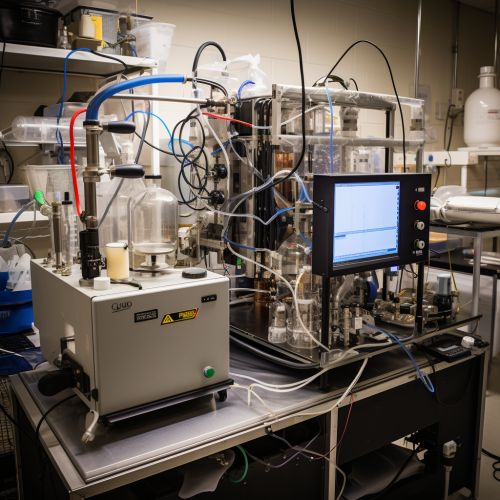Silica nanoparticles
Introduction
Silica nanoparticles are nanoscale particles of silicon dioxide, a compound that is the primary constituent of sand and various types of rock. These nanoparticles have a diameter of less than 100 nanometers and exhibit unique physical and chemical properties due to their small size and large surface area to volume ratio. They are widely used in various fields, including medicine, electronics, and materials science.


Properties
Silica nanoparticles possess a variety of properties that make them useful in a range of applications. These properties can be broadly categorized into physical, chemical, and optical properties.
Physical Properties
Silica nanoparticles are solid particles with a high surface area to volume ratio. This high surface area to volume ratio enhances their reactivity and interaction with other substances. They also have a high thermal stability and are resistant to degradation at high temperatures, making them suitable for use in high-temperature applications.
Chemical Properties
Chemically, silica nanoparticles are stable and inert. They are resistant to most chemical reactions, except for those involving hydrofluoric acid or strong alkalies. They can be functionalized with various chemical groups, allowing them to be tailored for specific applications.
Optical Properties
Silica nanoparticles exhibit unique optical properties due to their small size. They can scatter and absorb light in a manner different from bulk silicon dioxide, and these properties can be manipulated by altering the size and shape of the nanoparticles.
Synthesis
There are several methods for synthesizing silica nanoparticles, including sol-gel process, flame synthesis, microemulsion process, and precipitation method.
Sol-Gel Process
The sol-gel process is a widely used method for synthesizing silica nanoparticles. This process involves the transition of a system from a liquid 'sol' into a solid 'gel' phase. Tetraethyl orthosilicate (TEOS) is commonly used as a precursor in this process.
Flame Synthesis
Flame synthesis, also known as flame pyrolysis, is another method for synthesizing silica nanoparticles. This method involves the combustion of silicon compounds, such as silicon tetrachloride or hexamethyldisiloxane, in a flame to produce silica nanoparticles.
Microemulsion Process
The microemulsion process involves the use of surfactants to form microemulsion droplets, within which the silica nanoparticles are synthesized. This method allows for precise control over the size and shape of the nanoparticles.
Precipitation Method
The precipitation method involves the reaction of a silicon compound with a base to precipitate silica nanoparticles. This method is simple and cost-effective, but it offers less control over the size and shape of the nanoparticles compared to other methods.


Applications
Silica nanoparticles have a wide range of applications in various fields due to their unique properties.
Medicine
In medicine, silica nanoparticles are used in drug delivery systems. They can be functionalized with various chemical groups to carry drugs to specific parts of the body. They are also used in imaging and diagnostics, where their unique optical properties make them useful as contrast agents.
Electronics
In electronics, silica nanoparticles are used in the fabrication of devices such as transistors and capacitors. They are also used in the production of thin films and coatings.
Materials Science
In materials science, silica nanoparticles are used to enhance the properties of various materials. They can be incorporated into polymers to improve their mechanical and thermal properties. They are also used in the production of ceramics and composites.
Safety and Environmental Impact
Like all nanomaterials, the safety and environmental impact of silica nanoparticles is a subject of ongoing research. While they are generally considered to be safe, there is evidence that they can cause lung inflammation when inhaled. They can also have an impact on the environment, particularly aquatic ecosystems, where they can affect the behavior and survival of organisms.
